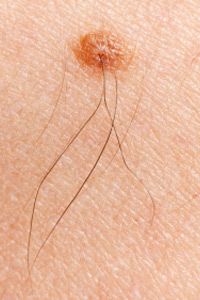Most people have had some sort of embarrassing skin problem to deal with in their lifetime. You know the names of most of these common conditions -- like acne, warts and blisters -- and probably already have a plan of attack for when they pop up. But there's at least one that many people have trouble identifying, let alone treating: acrochordons.
Commonly referred to as skin tags, acrochordons are small outgrowths of the skin that affect about 46 percent of the general population [source: Schwartz]. Fortunately, skin tags are relatively harmless and quite common.
Advertisement
Skin tags form just below the skin's surface. They usually consist of fat, nerve cells, fibers and ducts, all covered by skin [source: Crosta]. What is visible to the naked eye is a raised surface or small bump. Over time, skin tags can become a small mass connected by a stalk of skin, which wiggles as you move [source: Harvard Health Publications] Before you say "Ew!" know that skin tags are incredibly small -- usually only 0.08 to 0.19 inches (2 to 5 millimeters) [source: Schwartz].
Skin tags usually show up in areas of the body where there are skin folds, like armpits or eyelids. They also occur on more remote areas such as on the neckline, below the breasts or in the groin area [source: Crosta]. They occur equally in men and women but more often in adults over 60. Some research has shown that skin tags may be genetic, but that hasn't been definitively proven yet [source: Harvard Health Publications].
Once skin tags form, they do not go away on their own. Although they tend to be small, they can grow to the size of large grapes. But the good news is skin tags are not directly associated with a major medical condition and are not life threatening, though their appearance may alarm you if you've never had one [source: Alai]. Learning a little bit about why people get skin tags and how to treat them may help you reduce the likelihood of their occurrence or reoccurrence.
Read on find out what causes skin tags.
Advertisement

